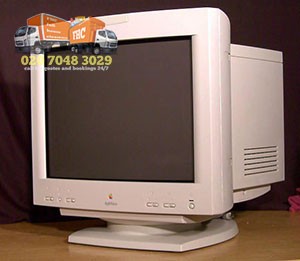Glass used in the manufacturing of cathode ray tube monitors (CRT screens) contains a certain amount of lead. As everyone knows, lead is a toxic metal that cannot be disposed of using conventional means as toxic emissions pollute water, air and soil. If lead is ingested by animals like fish or birds, it gets passed along the food chain until it reaches humans thus poisoning the human body. The US, being one of the biggest (former) producers and users of CRT monitors is stockpiling large amounts of lead containing CRT glass in warehouses around the country, simply because there are almost no recycling outlets for leaded CRT glass.
 The problem with growing piles of CRT leaded glass became quite apparent in twenty twelve. Until then there was no viable way to extract lead from glass so that either can be recycled separately. Having said this, there is no problem with collecting leaded CRT glass – rubbish removal for recyclable materials such as glass is efficient enough, it is what happens with leaded glass after that is the issue. Furthermore, in the last decade, more and more CRT screens are becoming redundant as their technology is now obsolete – again making the stockpile of leaded glass even bigger and menacing.
The problem with growing piles of CRT leaded glass became quite apparent in twenty twelve. Until then there was no viable way to extract lead from glass so that either can be recycled separately. Having said this, there is no problem with collecting leaded CRT glass – rubbish removal for recyclable materials such as glass is efficient enough, it is what happens with leaded glass after that is the issue. Furthermore, in the last decade, more and more CRT screens are becoming redundant as their technology is now obsolete – again making the stockpile of leaded glass even bigger and menacing.
A couple of years ago, one Simon Greer, founder of a company called Nulife Glass patented a furnace (which is now a trademark of Nulife Glass) that is able to melt and extract lead from CRT glass effectively. This allows for end of life glass from obsolete screens to be used in the manufacturing of new TVs and monitors. The problem with recycling of CRT glass and extracting its lead contents has become quite apparent in the last couple of years. A major US investigation into fraudulent CRT leaded glass practices uncovered how a US company was shipping leaded glass from California and dumping it in warehouses in Arizona, instead of recycling. The financial losses from the scam costed the state of California nearly four million dollars in total.
The government of California has imposed a so called ‘advanced recovery fee’ for every newly purchased TV or screen in the state. By doing this, authorities guarantee that recyclers will process the materials in question properly, once the TV or screen has reached end of its life. This is combined with federal regulations which prohibit the storage of non-recycled leaded glass for more than twelve months, again in order to stimulate the recycling of leaded glass. Now that the Nulife Glass patented furnace is in existence, there is no reason not to recycle leaded CRT glass. With ever growing amounts of leaded glass entering waste streams (in the US alone) the problem is becoming all the more obvious. There have been investigations launched into similar incidents in Denver and Baltimore.
It is estimated that currently, there are more than three hundred thousand tonnes of leaded CRT glass stockpiled in warehouses across the US. Many recycling companies which normally took leaded glass for recycling how now gone out of business but their massive stockpiles of leaded glass remain.



